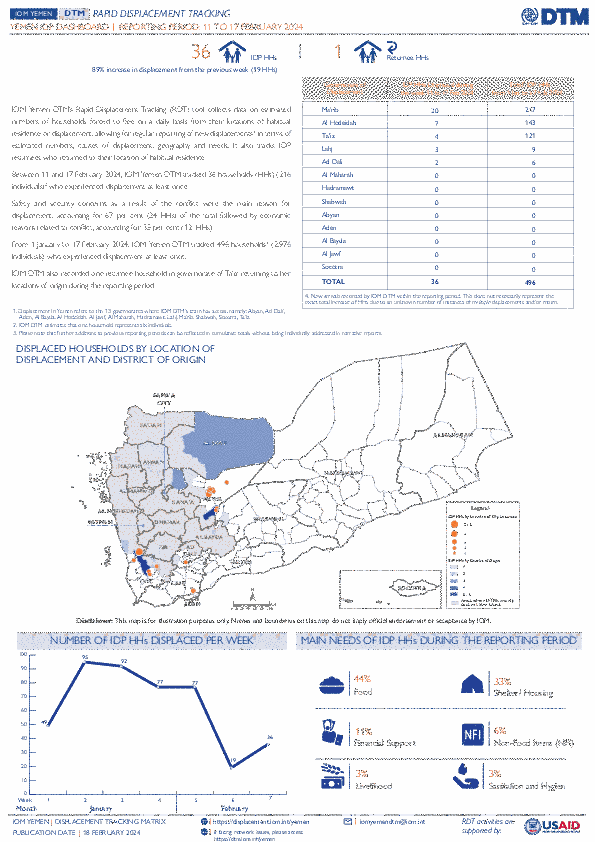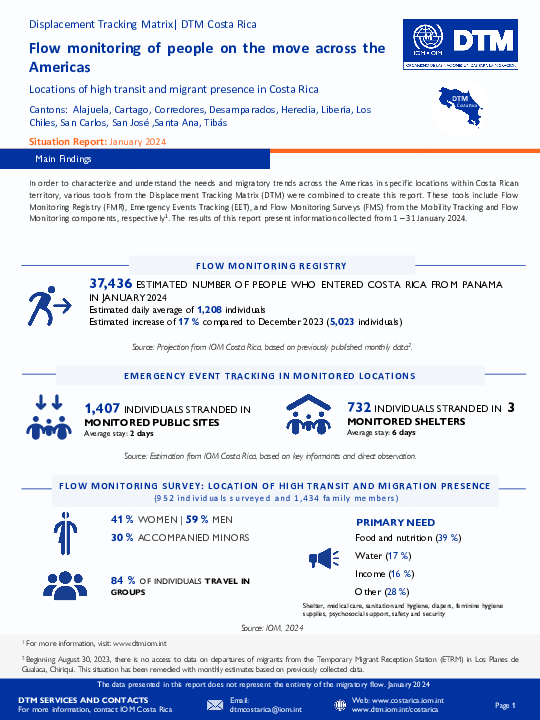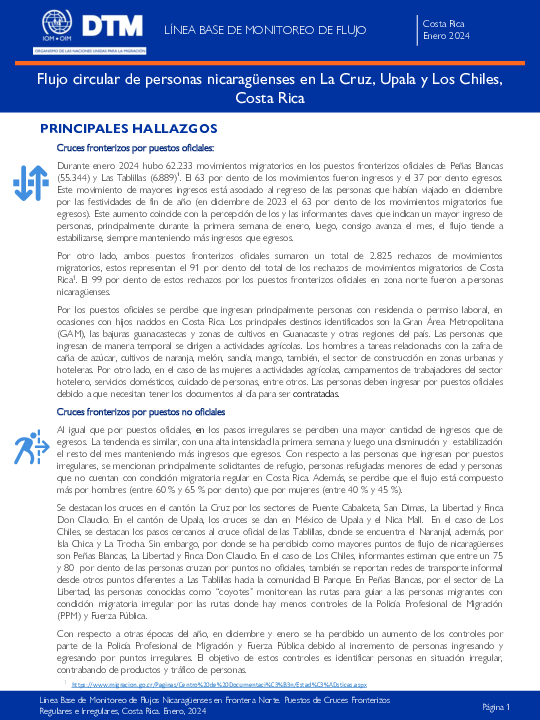-
Countries
-
Data and Analysis
-
Special Focus
-
Crisis Responses
Situation Report

Contact
DTM Nigeria, iomnigeriadtm@iom.int
Language
English
Location
Nigeria
Snapshot Date
Jan 06 2024
Activity
- Mobility Tracking
- Event Tracking
On 6 January 2024, a Non-State Armed Group (NSAG) carried out an attack in Gujba, Asheikri and Gabir/Maduri wards in Gujba, Geidam and Damaturu LGAs of Yobe State, leading to a substantial wave of population displacement.
As a result of the attack, a total of 9,965 individuals from 1,536 households were displaced from their homes forcing them to seek refuge in nearby communities or makeshift shelters.

Contact
DTM Yemen, iomyemendtm@iom.int
Language
English
Location
Yemen
Period Covered
Feb 11 2024
Feb 17 2024
Activity
- Mobility Tracking
- Event Tracking
IOM Yemen DTM’s Rapid Displacement Tracking (RDT) tool collects data on estimated numbers of households forced to flee on a daily basis from their locations of origin or displacement, allowing for regular reporting of new displacements in terms of estimated numbers, geography, and needs. It also tracks returnees who returned to their location of origin.
From 1 January to 17 February 2024, IOM Yemen DTM tracked 496 households (HH) (2,976 Individuals) who experienced displacement at least once.
Between 11 and 17 February 2024, IOM Yemen DTM tracked 36 households (216 individuals) displaced at least once. The majority of people moved into/within the following governorates and districts:
- Ma’rib (20 HHs) – Ma’rib City (9 HHs), Ma’rib (8 HHs), Harib (3 HHs) districts. Most displacements in the governorate originated from Ma’rib and Sanaa.
- Al Hodeidah (7 HHs) – Hays (6 HHs), Al Khukhah (1 HHs) districts. Most displacements in the governorate were internal.
- Ta’iz (4 HHs) – Maqbanah (3 HHs), Al Qahirah (1 HHs) districts. All displacements in the governorate were internal.
The majority of people moved from the following governorates and districts:
- Al Hodeidah (9 HHs) – Hays (6 HHs), At Tuhayta (2 HHs), Al Qanawis (1 HHs) districts.
- Ta’iz (8 HHs) – Maqbanah (5 HHs), Sharab As Salam (2 HHs), Sabir Al Mawadim (1 HHs) districts.
- Ma’rib (7 HHs) – Harib (6 HHs), Majzar (1 HHs) districts.
IOM identified 56 households displaced in the previous reporting period, which covered 04 - 10 February 2024, in the governorates of Ma’rib (27 HHs), Ta’iz (20 HHs), Al Hodeidah (9 HHs). These figures have been added to the cumulative displacement total recorded since the beginning of the year.

Contact
DTMMozambique@iom.int
Language
English
Location
Mozambique
Period Covered
Feb 08 2024
Feb 16 2024
Activity
- Mobility Tracking
- Event Tracking
Although included within this cumulative displacement estimate- the current Movement Alert #98 reports on recent attacks recorded in Macomia, Chiure and Mecu¬ between 8 to 16 February that displaced 4,212 individuals. Within this reporting period, arrivals of displaced families have been mapped across villages of Ancuabe, Macomia, Chiure, Muidumbe, Quissanga, Metuge, Montepuez, Mecufi¬, Erati and Ibo.
Of the total individuals displaced between 8-16 February, 249 families with 900 individuals have taken refuge in displacement centres of Chiure (Maningane, Muajaja, and Namisir) 143 families with 424 individuals have taken refuge in displacement centres of Macomia (Nanga A and Nanga B), 15 families with 64 individuals have taken refuge in displacement centre of Montepuez (Ntele), 18 families with 72 individuals have taken refuge in displacement centre of Metuge (Ngunga), 10 families with 19 individuals have taken refuge in displacement centre of Muidumbe (Lutete) 2 families with 16 individuals have taken refuge in displacement centre of Mueda (Lyanda) and 3 families with 8 individuals have taken refuge in displacement centres of Ancuabe (Cujupane, Nanjua).

Contact
DTMCostaRica@iom.int
Language
English
Location
Costa Rica
Period Covered
Jan 01 2024
Jan 30 2024
Activity
- Flow Monitoring
- Mobility Tracking
- Event Tracking
Cantons: Alajuela, Cartago, Corredores, Desamparados, Heredia, Liberia, Los Chiles, San Carlos, San José, Santa Ana y Tibás
Costa Rica, like the other countries in the Central American region, has been characterized as a migratory corridor for people who transit by land from the south to the north of America and whose destination is the countries in the north of the continent. This flow on the move through the Americas is mainly made up of people from the Bolivarian Republic of Venezuela, Cuba, Haiti, Ecuador, as well as people from other countries in South America, Africa and Asia.
According to estimations from IOM Costa Rica, during December 37,436 people entered the country, an approximate average of 1,208 people per day and estimating a increase of 30% compared to December 2023. In addition, 1,407 people stranded in the monitored shelters were identified and 732 people stranded in the public places visited.

Contact
Angélica Madrigal amadrigal@iom.int
Language
English
Location
Costa Rica
Period Covered
Jan 01 2024
Jan 30 2024
Activity
- Survey
- Registration
- Flow Monitoring
Cantones: Alajuela, Cartago, Corredores, Desamparados, Heredia, Liberia, Los Chiles, San Carlos, San José, Santa Ana y Tibás
Costa Rica, al igual que los demás países de la región centroamericana, se ha caracterizado por ser un corredor migratorio para personas que transitan de manera terrestre desde el sur hasta el norte de América y que tienen como destino los países del norte del continente. Este flujo en situación de movilidad por las Américas se encuentra compuesto principalmente por personas de la República Bolivariana de Venezuela, Cuba, Haití, Ecuador, así como personas provenientes de otros países de Suramérica, África y Asia.
Según estimaciones de la OIM Costa Rica, durante enero ingresaron al país 37.436 personas, un promedio aproximado de 1.208 personas por día y estimando un aumento de un 30% con respecto a diciembre de 2023. Además, se identificaron 1.407 personas varadas en los albergues monitoreados y 732 personas varadas en los sitios públicos visitados.

Contact
DTMCostaRica@iom.int
Language
English
Location
Costa Rica
Period Covered
Jan 01 2024
Jan 31 2024
Activity
- Flow Monitoring
- Baseline Assessment
La Organización Internacional para las Migraciones (OIM), como agencia de las Naciones Unidas en materia de migración en Costa Rica, implementó, desde 2021, dos rondas de la Matriz de Seguimiento al Desplazamiento (DTM por sus siglas en inglés) como parte de su estrategia de monitoreo del flujo migratorio circular de personas de nacionalidad nicaragüense, en puntos fronterizos no oficiales, en distintos cantones del norte del país. A partir de este ejercicio en tres puntos de ingreso no oficial de la frontera con Nicaragua, se contabilizaron 60 697 movimientos migratorios, de los cuales el 59 por ciento fueron egresos y 41 por ciento ingresos.
Siendo parte fundamental de la misión de OIM brindar asesoría clave sobre políticas y prácticas migratorias, se vuelve necesario actualizar los datos de este flujo migratorio circular de nicaragüenses que cruzan tanto de forma regular como irregular la frontera norte de Costa Rica.
Según los registros de la DGME de ingresos y egresos regulares por puestos fronterizos oficiales en Los Chiles y Peñas Blancas, en 2022 hubo 394.730 movimientos migratorios regulares (50 % ingresos y 50 % egresos). Durante el 2023, en total se registraron 526.271 movimientos migratorios (50 % ingresos y 50 % egresos) . Los movimientos migratorios de 2023 superaron en un 33,3 por ciento los de 2022. Durante enero del 2024, se han realizado un total de 62.233 movimientos migratorios siendo el 63 por ciento ingresos y el 37 por ciento egresos.

Contact
DTMMozambique@iom.int
Language
English
Location
Mozambique
Period Covered
Feb 08 2024
Feb 14 2024
Activity
- Mobility Tracking
- Event Tracking
Between 22 December to 12 February, a series of sporadic attacks and fear of attacks by Non-state Armed Groups in Macomia, Chiure, Mecufi, Mocimboa da Praia, and Muidumbe triggered the cumulative displacement 12,963 individuals/2,047 families.
Although included within this cumulative displacement estimate- the current Movement Alert #97 reports on recent attacks recorded in Macomia, Chiure and Mecufi between 8 to 14 February that displaced 2,114 individuals. Within this reporting period, arrivals of displaced families have been mapped across villages of Ancuabe, Macomia, Chiure, Muidumbe, Quissanga, Metuge, Montepuez, Mecufi, Erati and Ibo.
Of the total individuals displaced between 8-14 February, 128 families with 348 individuals have taken refuge in displacement centers of Macomia (Nanga A and Nanga B), 190 families with 676 individuals have taken refuge in displacement centers of Chiure (Maningane, Muajaja, and Namisir), 15 families with 64 individuals have taken refuge in displacement centers of Montepuez (Ntele), 17 families with 68 individuals have taken refuge in displacement centers of Metuge (Ngunga), 2 families with 16 individuals have taken refuge in displacement centers of Mueda (Lyanda) and 3 families with 8 individuals have taken refuge in displacement centers of Ancuabe (Cujupane, Nanjua).

Contact
DTM Ethiopia, DTMEthiopia@iom.int
Language
English
Location
Ethiopia
Period Covered
Aug 01 2023
Sep 02 2023
Activity
- Mobility Tracking
- Site Assessment
- Village Assessment
Between August and September 2023, the International Organization for Migration (IOM) Data and Research Unit (DRU), through its Displacement Tracking Matrix (DTM) methodology, deployed the Site Assessment(SA) and Village Assessment Survey (VAS) tools to assess the mobility, needs and vulnerabilities of Internally Displaced Persons (IDPs) and returning IDPs across Ethiopia.
This snapshot report will present key findings on needs and vulnerabilities, and will focus on Shelter and Non-Food Items (NFIs) in the locations assessed through the SA and VAS survey tools.
According to data collected, living conditions of IDPs in the assessed sites continue to be inadequate and unsafe. In 42.10% of assessed sites, no HHs were living in individual HH shelters. Furthermore, in 60.77% of sites there was no lighting in communal spaces and in 36.08% there was lighting but it was not adequate.
Between 22 December to 12 February, a series of sporadic attacks and fear of attacks by Non-state Armed Groups in Macomia, Mecufi, Mocimboa da Praia, and Muidumbe triggered the cumulative displacement 10,849 individuals/1,478 families.
Although included within this cumulative displacement estimate- the current Movement Alert #96 reports on recent attacks recorded in Macomia, Chiure and Mecufi between 8 to 12 February that displaced 812 individuals. Within this reporting period, arrivals of displaced families have been mapped across villages of Macomia, Chiure, Metuge, Montepuez, Mecufi, Erati and Ibo.Of the total individuals displaced between 8-12 February, 47 families with 139 individuals have taken refuge in displacement centers of Macomia (Nanga A and Nanga B), 35 families with 108 individuals have taken refuge in displacement centers of Chiure (Maningane, Muajaja, and Namisir), 10 families with 45 individuals have taken refuge in displacement centers of Montepuez (Ntele), and 2 families with 22 individuals have taken refuge in displacement centers of Metuge (Ngunga).

Contact
DTM Ethiopia, DTMEthiopia@iom.int
Language
English
Location
Ethiopia
Period Covered
Nov 25 2022
Jan 08 2023
Activity
- Mobility Tracking
- Village Assessment
This snapshot report will present data on returned migrants from abroad collected by the International Organization for Migration (IOM) through its Displacement Tracking Matrix (DTM) methodology and Village Assessment Survey (VAS) tool in the Amhara and Oromia regions of Ethiopia between November 2022 and January 2023. A total of 21,832 returned migrants from abroad were identified in 730 villages in Amhara region and 4,812 returned migrants from abroad were identified in 174 villages in Oromia region.
Pagination
- Previous page
- Page 18
- Next page
